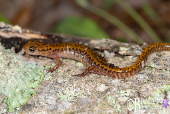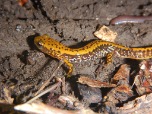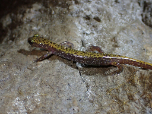Dark-Sided Salamander (Eurycea melanopleura)
Description: Dark-sided salamanders can reach up to 6.5 inches in total length, but most individuals vary from 4 to 6 inches in total length. Dark-sided salamanders are moderately small, thin-bodied salamanders with broad heads, large eyes, and relatively long legs. The background color is yellow to orange and the body, tail, and legs are covered with irregular black markings. The lower sides of the body are white with black markings. Black markings along the sides of the body where the background color changes from yellow or orange to white form an irregular black stripe that extends from the eye, down the side of the body, and down the tail. In addition, the head is relatively large and the eyes protrude well above the head. The thin tail is considerably longer than the body and is slightly compressed laterally in cross section. Dark-sided salamanders have 13 to 14 costal grooves.
Habitat: It can be found in streamsides, spring runs, cave mouths and abandoned mines. Animals may disperse into wooded terrestrial habitats in wet weather. It hides in rock crevices and under rocks, logs and other debris. Individuals were found in abandoned mines, suggesting at least a degree of tolerance to habitat degradation.
Range: The distribution of dark-sided salamanders in North America extends west to east from northeastern Oklahoma across most of the eastern United States and north to south from at least New York to the coastal plain of Alabama and Mississippi. Populations outside of the Ozark region are considered to be a separate subspecies.
Diet: This salamander feeds on small insects and spiders.
Reproduction: Eggs are laid in underground crevices associated with springs, temporary pools and streams; under rocks in streams; in woodland ponds; or are attached to objects in or above water in caves. Females deposit clutches of eggs in pools of water in limestone caves and fissures from December through March. The aquatic larvae usually follow trickles of water out of caves and live in clear pools on the surface where more food is available. Overall, the natural history of this species is poorly known.
Status: Listed as Least Concern in view of its wide distribution and presumed large population.
Taxonomy: Taxonomic Split 138973 (Committed on 02-06-2024): Eurycea longicauda split into Eurycea longicauda and Eurycea melanopleura
»» Kingdom: Animalia - Animals
»» Phylum: Chordata - Chordates
»» Subphylum: Vertebrata - Vertebrates
»» Class: Amphibia - (Amphibians)
»» Order: Caudata - Salamanders
»» Family: Plethodontidae - Lungless Salamanders
»» Genus: Eurycea
»» Species: Eurycea melanopleura - Dark-Sided Salamander
This article uses material from the Wikipedia article "Eurycea longicauda", which is released under the Creative Commons Attribution-Share-Alike License 3.0. Content may have been omitted from the original, but no content has been changed or extended.
|













